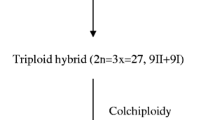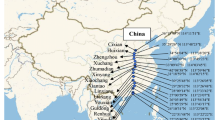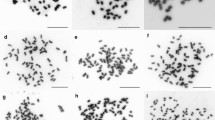Abstract
Dioscorea alata is a polyploid species with several ploidy levels and its basic chromosome number has been considered by most authors to be x = 10. Standard chromosome counting and flow cytometry analysis were used to determine the chromosome number of 110 D. alata accessions of the CIRAD germplasm collection. The results revealed that 76% of accessions have 2n = 40 chromosomes, 7% have 2n = 60 chromosomes and 17% have 2n = 80 chromosomes. Progenies were produced from 2n = 40 types of D. alata and the segregation patterns of six microsatellite markers in four different progenies were analysed. The Bayesian method was used to test for diploid versus tetraploid (allo- and autotetraploid) modes of inheritance. The results provided the genetic evidence to establish the diploidy of plants with 2n = 40 chromosomes and to support the hypothesis that plants with 2n = 40, 60 and 80 chromosomes are diploids, triploids and tetraploids, respectively, and that the basic chromosome number of D. alata is x = 20. The findings obtained in the present study are significant for effective breeding programs, genetic diversity analysis and elucidation of the phylogeny and the species origin of D. alata.


Similar content being viewed by others
References
Abraham K (1998) Occurrence of hexaploid males in Dioscorea alata L. Euphytica 99:5–7
Abraham K, Nair PG (1991) Polyploidy and sterility in relation to sex in Dioscorea alata L. (Dioscoreaceae). Genetica 83:93–97
Ayensu ES, Coursey DG (1972) Guinea yams. The botany, ethnobotany, use and possible future of yams in West Africa. Econ bot 26:301–318
Beaumont MA, Rannala B (2004) The Bayesian revolution in genetics. Nat Rev Genet 5:251–261
Bousalem M, Arnau G, Hochu I, Arnolin R, Viader V, Santoni S, David J (2006) Microsatellite segregation analysis and cytogenetic evidence for tetrasomic inheritance in the American yam Dioscorea trifida and a new basic chromosome number in the Dioscoreae. Theor Appl Genet 113:439–451
Catalán P, Segarra-Moragues JG, Palop-Esteban M, Moreno C, Gonzalez-Candelas F (2006) A Bayesian approach for discriminating among alternative inheritance hypotheses in plant polyploids: the allotetraploid origin of genus Borderea (Dioscoreaceae). Genetics 172:1939–1953
Degras L (1993) The yam. A tropical root crop. In: Coste T (ed) MacMillan/ CTA, London and Basingstoke, 408 pp
Essad S (1984) Variation géographique des nombres chromosomiques de base et polyploïdie dans le genre Dioscorea à propos du dénombrement des espèces transversa Brown, pilosiuscula Bert et trifida. Agron 4:611–617
Gamiette F, Bakry F, Ano G (1999) Ploidy determination of some yam species (Dioscorea spp.) by flow cytometry and conventional chromosomes counting. Genet Resour Crop Evol 46:19–27
Hamon P, Brizard JP, Zoundjihekpon J, Duperray C, Borgel A (1992) Etude des index d’ADN de huit espèces d’ignames (Dioscorea sp.) par cytométrie en flux. Can J Bot 70:996–1000
Hochu I, Santoni S, Bousalem M (2006) Isolation, characterization and cross-species amplification of microsatellite DNA loci in the tropical American yam Dioscorea trifida. Mol Ecol Notes 6:137–140
Kass R, Raftery A (1995) Bayes factors. J Am Stat Assoc 90:773–795
Lyttle TW (1991) Segregation distortion. Annu Rev Genet 25:511–557
Malapa R, Arnau G, Noyer JL, Lebot V (2005) Genetic diversity of the greater yam (Dioscorea alata L.) and relatedness to D. nummularia Lam. and D. transversa Br. as revealed with AFLP markers. Genet Resour Crop Evol 52:919–929
Mignouna HD, Mank RA, Ellis THN, Van den Bosch N, Asiedu R, Abang MM, Peleman J (2002) A genetic linkage map of water yam (Dioscorea alata L) based on AFLP markers and QTL analysis for anthracnose resistance. Theor Appl Genet 105:726–735
Misuki I, Tani N, Ishida K, Tsumura Y (2005) Development and characterization of microsatellite markers in a clonal plant, Dioscorea japonica Thunb. Mol Ecol Notes 5:721–723
Ollitrault P, Jacquemond C (1994) Facultative apomixis, spontaneous polyploidization and inbreeding in Citrus volkameriana seedlings. Fruits 49:398–400
Olson MS (1997) Bayesian procedures for discriminating among hypotheses with discrete distributions: inheritance in the tetraploid Astilbe biternub. Genetics 147:1933–1942
Posada D, Buckley TR (2004) Model selection and model averaging in phylogenetics: advantages of Akaike information criterion and Bayesian approaches over likelihood ratio tests. Syst Biol 53:793–808
Prain D, Burkill IH (1939) An account of the genus Dioscorea. 1. Species which turn to the right. Ann Rev Bot Gard 14:211–528
Ramachandran K (1968) Cytological studies in Dioscorea. Cytologia 33:401–410
Scarcelli N, Daïnou O, Agbangla C, Tostain S, Pham JL (2005) Segregation patterns of isozyme loci and microsatellite markers show the diploidy of African yam Dioscorea rotundata (2n = 40). Theor Appl Genet 111:226–232
Sharma AK, De DN (1956) Polyploidy in Dioscorea. Genetica 28:112–120
Sharma AK, Sharma A (1957) Investigations leading to a new theory of differentiation in plant cells. Genet Iber 9:143–162
Sundara Raghavan R (1958) A chromosome survey of Indian Dioscoreas. Proc Indian Acad Sci Sect B 48:59–63
Taylor DR, Ingvarsson PK (2003) Common features of segregation distortion in plants and animals. Genetica 117:27–35
Tostain S, Scarcelli N, Brottier P, Marchand JL, Pham JL, Noyer JL (2006) Development of DNA microsatellite markers in tropical yam (Dioscorea sp.). Mol Ecol Notes 6:173–175
Van Ooijen JW (2006) JoinMap 4, software for the calculation of genetic linkage maps in experimental populations. Kyazma BV, Wageningen
Zamir D, Tadmor Y (1986) Unequal segregation of nuclear genes in plants. Bot Gaz 147(3):335–358
Acknowledgments
The authors express their sincere gratitude to IFCPAR (Indo-French Centre for the Promotion of Advanced Research) for supporting this work. We thank Dr. J. David who provide us with the programme to calculate the Bayesian probabilities, and Dr A. D’Hont, D. Triaire and M. Goud who provided support for the chromosome counting.
Author information
Authors and Affiliations
Corresponding author
Additional information
Communicated by J. Bradshaw.
Rights and permissions
About this article
Cite this article
Arnau, G., Nemorin, A., Maledon, E. et al. Revision of ploidy status of Dioscorea alata L. (Dioscoreaceae) by cytogenetic and microsatellite segregation analysis. Theor Appl Genet 118, 1239–1249 (2009). https://doi.org/10.1007/s00122-009-0977-6
Received:
Accepted:
Published:
Issue Date:
DOI: https://doi.org/10.1007/s00122-009-0977-6




